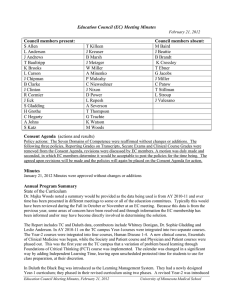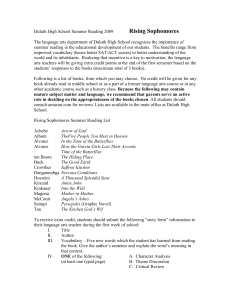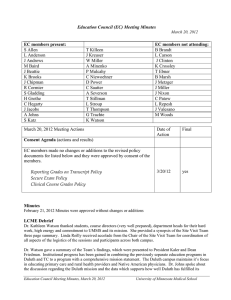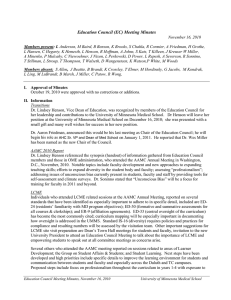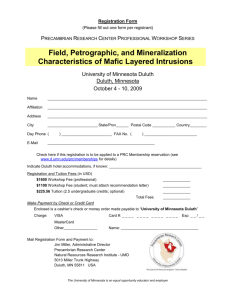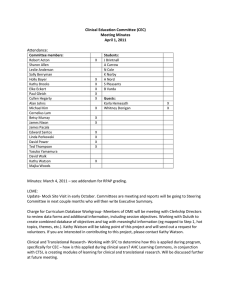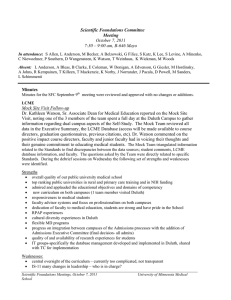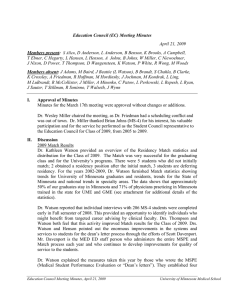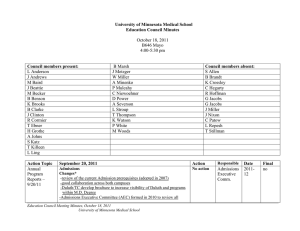Education Council (EC) Meeting Minutes
advertisement
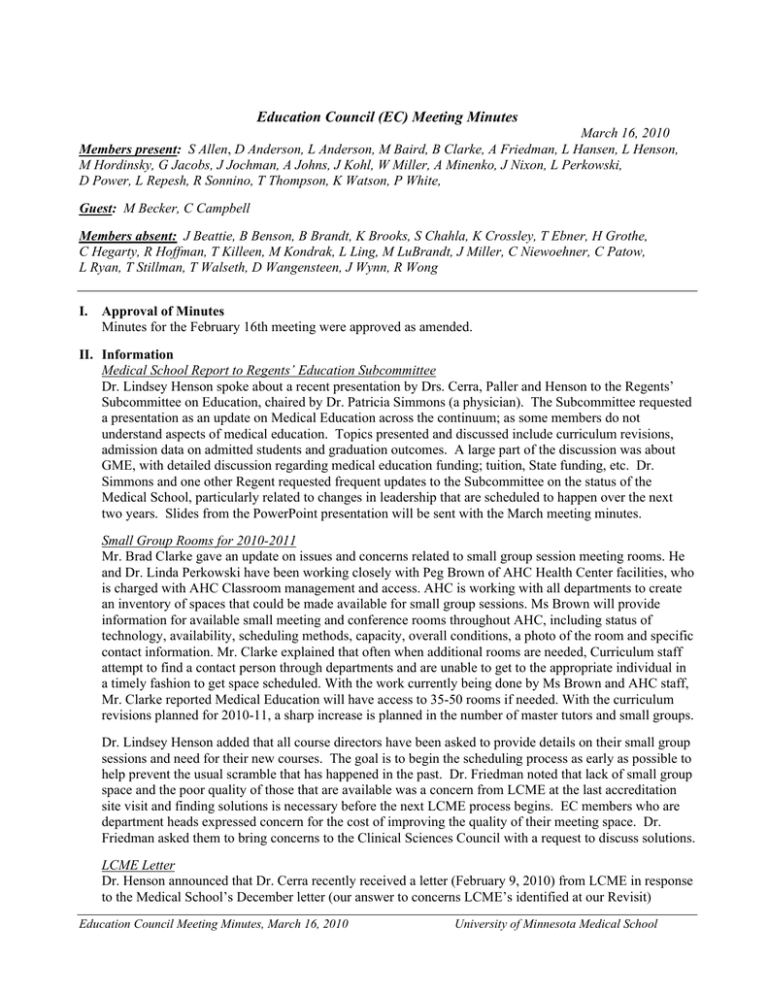
Education Council (EC) Meeting Minutes March 16, 2010 Members present: S Allen, D Anderson, L Anderson, M Baird, B Clarke, A Friedman, L Hansen, L Henson, M Hordinsky, G Jacobs, J Jochman, A Johns, J Kohl, W Miller, A Minenko, J Nixon, L Perkowski, D Power, L Repesh, R Sonnino, T Thompson, K Watson, P White, Guest: M Becker, C Campbell Members absent: J Beattie, B Benson, B Brandt, K Brooks, S Chahla, K Crossley, T Ebner, H Grothe, C Hegarty, R Hoffman, T Killeen, M Kondrak, L Ling, M LuBrandt, J Miller, C Niewoehner, C Patow, L Ryan, T Stillman, T Walseth, D Wangensteen, J Wynn, R Wong I. Approval of Minutes Minutes for the February 16th meeting were approved as amended. II. Information Medical School Report to Regents’ Education Subcommittee Dr. Lindsey Henson spoke about a recent presentation by Drs. Cerra, Paller and Henson to the Regents’ Subcommittee on Education, chaired by Dr. Patricia Simmons (a physician). The Subcommittee requested a presentation as an update on Medical Education across the continuum; as some members do not understand aspects of medical education. Topics presented and discussed include curriculum revisions, admission data on admitted students and graduation outcomes. A large part of the discussion was about GME, with detailed discussion regarding medical education funding; tuition, State funding, etc. Dr. Simmons and one other Regent requested frequent updates to the Subcommittee on the status of the Medical School, particularly related to changes in leadership that are scheduled to happen over the next two years. Slides from the PowerPoint presentation will be sent with the March meeting minutes. Small Group Rooms for 2010-2011 Mr. Brad Clarke gave an update on issues and concerns related to small group session meeting rooms. He and Dr. Linda Perkowski have been working closely with Peg Brown of AHC Health Center facilities, who is charged with AHC Classroom management and access. AHC is working with all departments to create an inventory of spaces that could be made available for small group sessions. Ms Brown will provide information for available small meeting and conference rooms throughout AHC, including status of technology, availability, scheduling methods, capacity, overall conditions, a photo of the room and specific contact information. Mr. Clarke explained that often when additional rooms are needed, Curriculum staff attempt to find a contact person through departments and are unable to get to the appropriate individual in a timely fashion to get space scheduled. With the work currently being done by Ms Brown and AHC staff, Mr. Clarke reported Medical Education will have access to 35-50 rooms if needed. With the curriculum revisions planned for 2010-11, a sharp increase is planned in the number of master tutors and small groups. Dr. Lindsey Henson added that all course directors have been asked to provide details on their small group sessions and need for their new courses. The goal is to begin the scheduling process as early as possible to help prevent the usual scramble that has happened in the past. Dr. Friedman noted that lack of small group space and the poor quality of those that are available was a concern from LCME at the last accreditation site visit and finding solutions is necessary before the next LCME process begins. EC members who are department heads expressed concern for the cost of improving the quality of their meeting space. Dr. Friedman asked them to bring concerns to the Clinical Sciences Council with a request to discuss solutions. LCME Letter Dr. Henson announced that Dr. Cerra recently received a letter (February 9, 2010) from LCME in response to the Medical School’s December letter (our answer to concerns LCME’s identified at our Revisit) Education Council Meeting Minutes, March 16, 2010 University of Minnesota Medical School regarding faculty resources, student diversity and integration across the TC and Duluth campuses. In the February letter, LCME informed Dean Cerra all information submitted has sufficiently answered their questions. Mr. Paul White, Associate Dean of Admissions, asked if specifics of our current level of diversity will be part of the self study and site visit. Dr. Henson responded that they have increased the number of standards regarding “diversity” with more specific language. LCME will focus on recruitment strategies; requiring a definition of what we are looking for in diversity and specifics of what is being done to achieve diversity at the level of students, residents and faculty. In the past their focus has been on numbers and their goal is to change that approach. Duluth Task Force Report Dr. Alan Johns responded that the basis for the Task Force created by Dr. Cerra was to address the education and research plans most relevant to the Duluth Campus. Dr. Gary Davis and Dr. Mark Paller served as co-chairs, with members appointed from both campuses. Three major charges to the Task Force was to identify 1) a strategic plan for education and a plan for research, and to determine the optimal composite size of the Duluth faculty. Task Force members established that Duluth will continue to do what they have done well; teaching the rural and Native American health track, while expanding Duluth’s role in year 3 & 4 activities in community based experiences. The Research plan is to focus research involving rural health and Native American health and educational research in support of a medical education lab on the Duluth Campus. Drs. Repesh and Johns provided details of planned recruitment and hiring to replace faculty, which will be done in two phases in response to the two planned waves of retirement. The first wave will occur during 2011 and 2012 and the second wave will take place in 2014 and 2015. Because of the number of faculty lost since 2007, it should be possible to hire two new faculty before current faculty take retirement. Through work of theTask Force, Duluth has realigned its goals for new faculty recruitment to match their strategic plan of focus on teaching rural and Native American health. The revised plan for hiring is expected to be successful as supported by their goal to seek and hire faculty matched to this focus. Dr. Perkowski added because retirement issues were identified during the previous accreditation process, LCME is aware of the need to hire faculty and time sensitive issues surrounding these circumstances. The implementation phase will include subcommittees to the Task Force for each of the identified goals. The Duluth contingency for each Subcommittee has been selected. Duluth administration will keep the Council updated on developments in this new phase. III. Discussion Annual Summaries – SSC, Duluth and COSSS, Twin Cities Dr. Repesh gave an overview of the Scholastic Standing Committee’s (Duluth) structure and functions. She noted there three standing meeting held within a month of the end of Fall, Spring and Summer semesters. At mid-semester they assess whether there are concerns which need attention and the can call emergent meetings when the need arises. Progress for each student is assessed and presented to the Faculty Assembly, the actions and decisions are reviewed and recommendations are reported to the Senior Associate Dean, Dr. Gary Davis. At this point Dr. Repesh is in communication with Dr. Kathleen Watson, Associate Dean for Students and Student Learning on the Twin Cities campus. Duluth’s process includes closely following student progress and failure of a course(s) generates immediate intervention to identify solutions and remediation to assist students in areas of concern. Remediation for a year 2 course can often require that a student take a year off and repeat the course the course at Duluth. Dr. Repesh feels it is most often a personal issue involving health or family emergency that overwhelms individual students and creates barriers to completing their MD degree. Dr. Watson provided an overview of COSSS membership and structure, noting they meet monthly, usually with a very full agenda. She introduced Dr. Colin Campbell, who chairs COSSS and has served on the Committee for a number of years. Dr. Watson reported reviewing five years of data, which has Education Council Meeting Minutes, March 16, 2010 University of Minnesota Medical School allowed her to begin to identify trends across both campuses. The review of data helped identify risk factors and gives insight into advantages for early intervention and tracking over time. Across both campuses there appears to be correlation between failure of one or more year 1 and 2 courses and/or Step 1; and individuals at risk for problems in completing years 3 and 4 required clerkships. Drs. Repesh and Watson agree that students who experience personal problems (i.e. severe health issues/illness, death of family members), are at risk and often experience delay in graduation. Participants in the Flex MD program typically delay graduation by a year to take part in an academic enrichment program. Dr. Watson noted that they are required to submit a plan and have a mentor; their progress in their program is tracked to ensure credit toward completing graduation requirements. Most select rural health, while others choose a research program. Dr. Watson did express concern because in the last 4 years no students have received some of the more prestigious research grants toward physician scientist status. Discussion followed Dr. Watson’s report and several questions were raised. Reference to difficulties in passing required clerkships; do failures relate to not passing shelf exams (shelf exams are a portion of the grade)? Drs. Watson and Nixon noted that failure is usually involves some academic problems (lack of knowledge) along with other issues knowledge based issues. But in some cases poor attendance, ignoring pages, not covering shifts, not attending rounds, etc. can be reason for failure. These behaviors fall under professionalism and failure of professionalism can be cause for failing a clerkship. OB and Med I clerkships are most often the clerkships that students fail. Council members discussed whether this was a concern, asking if others there are others missed in clerkships with different standards? Suggestions were made to allow sharing of information about student performance between directors; Dr. Thompson reported that the process exists if a student signs a permission form. Dr. Henson added that during Clinical Education Retreats, held during 2009, clerkship directors proposed clustering clerkships within the same facilities and during transition periods for the next required clerkship, sharing performance related information would be a more natural process. She noted that this will be part of a discussion for a plan for clerkships revisions. She and Dr. Watson both spoke about the Faculty Adviser role in seeing a much broader scope of student performance and will be more able to identify issues of concern that may be flagged as a potential problem but do not become part of a grade. Recommendations were proposed by students for improved methods of feedback; from clerkship directors regarding variability in how to guide and teach; and suggestions from Dr. Roberta Sonnino regarding faculty development to implement consistent standards of assessing, grading and communicating feedback to students. Dr. Friedman thanked Council members for thoughtful discussion and input; he made a recommendation that suggestions be considered for implementation. Next Education Council Meeting – Tuesday, April 27th, 4:00-5:30 pm, B620 Mayo Bldg Dr. Scott Schroth, MD, MPH, Visiting Professor Sr. Associate Dean for Academic Affairs George Washington University, School of Medicine and Health Science Education Council Meeting Minutes, March 16, 2010 University of Minnesota Medical School
